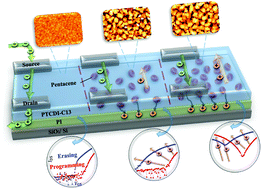Memory characteristics of organic field-effect memory transistors modulated by nano-p–n junctions†
Abstract
The interfaces between dielectric films and organic semiconductors are used as carrier traps in organic memory devices. The trapping and release capabilities of carriers must be controlled in memory devices. However, the memory windows of these devices are limited by the carriers' erasing capability. In this work, a series of nano-pentacene films were inserted into n-type dioctyl perylene tetracarboxylic diimide (PTCDI-C13) semiconductor layers near the interface of a dielectric film and an organic semiconductor to form field-effect type memory devices with nano-p–n junctions. The presence of nano-p–n junctions near the interface increased minorities (i.e., holes), which could effectively erase accumulated electrons at the interface during erasing. We achieved a maximum memory window of 48.9 V when a 5 nm-thick pentacene film was inserted into the PTCDI-C13 layer and the memory device was operated under a programming process of 90 V and an erasing process of −90 V. Kelvin probe force and noncontact atomic force microscopy were used to investigate the monolayer growth of pentacene and PTCDI-C13 as well as their interface properties. Although the thickness of the pentacene film reached 10 nm, an incomplete layer was formed. This layer supported minorities during erasing and transmitted electrons during programming. A wide memory window was achieved by the nano-p–n heterojunction field-effect memory transistor. This high-performance organic memory device has potential applications in fresh-type memory devices.



 Please wait while we load your content...
Please wait while we load your content...